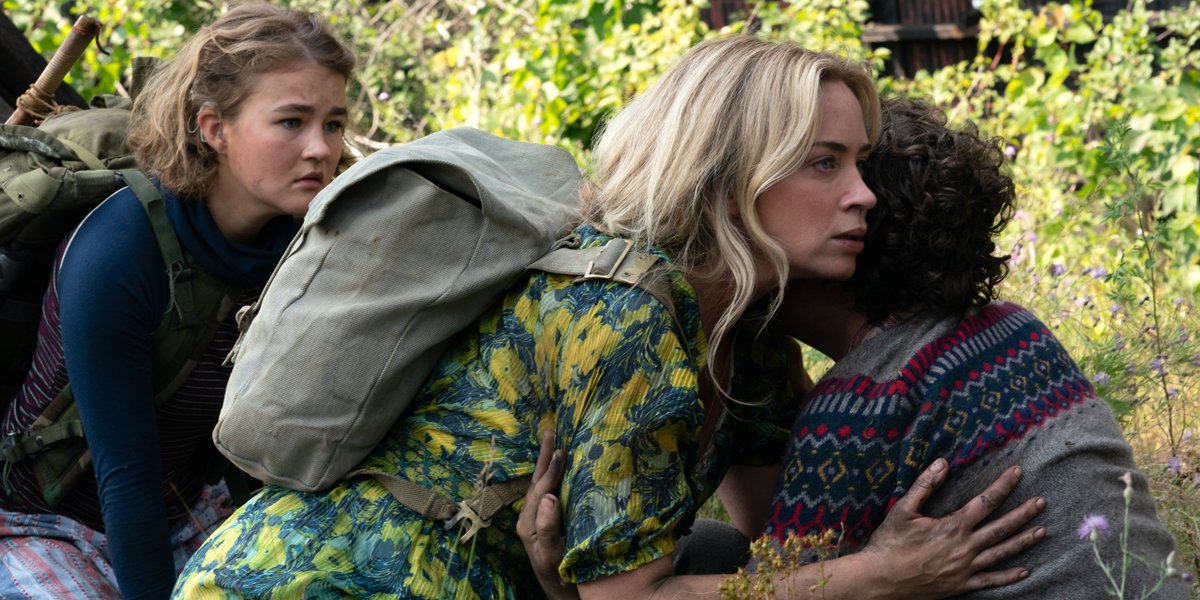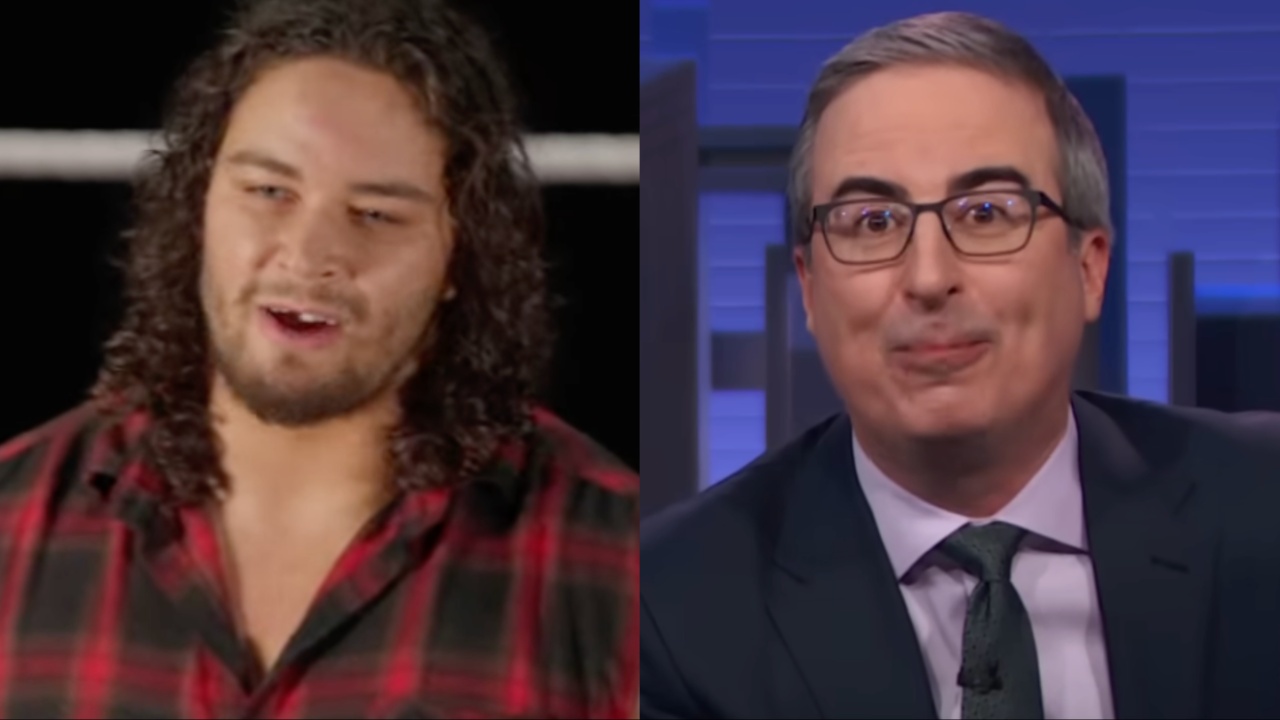The ending of John Krasinski’s A Quiet Place is a fascinating one in that it paradoxically serves as both a satisfying conclusion and an effective cliffhanger. On the one hand, it drives home that the main characters have figured out a way to defeat the deadly alien invasion plaguing the planet, but on the other hand it’s made clear that victory is no sure thing while facing off against such a fast and powerful enemy. You are left being able to conceive how the rest of the story will play out, but at the same time are not totally confident that everything will wrap up happily. It’s a strange blend, but works perfectly for the movie that arrived with zero promise of a follow-up.
Three years later we are now seeing the arrival of the sequel, A Quiet Place: Part II… and it has added another odd dimension to its predecessor’s unique finish. This is because while the previous chapter invited audiences to imagine how things play out past its final moment, the new film takes on the challenge of making those specific events concrete and canon. And while that’s a job that the movie performs effectively – with a strong grip on its protagonists, scenario, and big scares – it also has a strange side effect that sees the story not so much play like something that builds on what has been established, but instead like a lost second half.
Written and directed by John Krasinski, A Quiet Place: Part II begins with a flashback that allows audiences to witness the sound-sensitive extraterrestrials’ arrival on Earth, but then it immediately jumps back to the very second we left the surviving members of the Abbott family. Their home equal parts destroyed, burned, and flooded, Evelyn (Emily Blunt), Regan (Millicent Simmonds), Marcus (Noah Jupe), and the new baby have no choice but to venture beyond the borders of their property and find safe haven elsewhere – their chosen target being a far off camp that has been burning signal fires. At the same time, Regan is confident that the upgraded cochlear implant that her father (Krasinski) built is the key to defeating the violent invaders, and works to figure out a way to best utilize it.
After days of silent and dangerous travel, the Abbotts reach their destination, an old industrial complex, and wind up reconnecting with an old family friend named Emmett (Cillian Murphy), but he is hardly excited to see them – possessing limited resources and having lost his own wife and children. He has no plans to let them stay, but before he can kick them out Regan makes the decision to head out on her own. Having learned of a radio station still broadcasting a signal from a local island, she becomes convinced that it is the key she needs for her special tool, but while she travels she discovers that there are still plenty of humans around who have the potential to be as deadly and dangerous as the monstrous aliens.
A Quiet Place Part II expands on the original story, but it’s mostly just more of the same.
John Krasinski makes a clear case that he perfectly understands what people connected with in the first A Quiet Place, which made brilliant and clever use of sound in its plot and aesthetic, but what’s unfortunate about the sequel is that it doesn’t do much to advance the ideas the filmmaker presented that first time around; it simply doubles down on them. While you would hope that a second film would reveal new and terrifying information about the aliens not accessible by the first story, or find an even more effective way of defeating them than slamming a cochlear implant against a microphone and firing a shotgun, Part II doesn’t travel down any of those avenues.
For example, while the opening flashback allows audiences to learn what it was like for the characters the day the world ostensibly ended, the only new piece of information provided by the sequence is the retconned relationship with Emmett, which isn’t even particularly deep. Even the promise of human survivors who are just as scary as the otherworldly predators only ultimately amounts to a single scene, and it’s about as memorable as the bit from the first A Quiet Place when John Krasinski and Noah Jupe’s characters encounter Leon Russom’s screaming man in the woods.
Nothing about the material undercuts what was effective in the previous movie, as it realistically extends the narrative as it was established and does so in ways that are logical and fit – but A Quiet Place Part II is lacking in the novelty department, and that by itself makes it a less exciting chapter.
Plenty of scary sequences and great performances let A Quiet Place Part II mostly work.
The sequel doesn’t have the same kind of spark that allowed A Quiet Place to become such a massive hit in early 2018, but what it certainly does lean on are the great inherited character and style strengths. Following her terrific breakout role in the first film, Millicent Simmonds delivers another great turn as Regan, demonstrating impressive confidence and determination as the character evolves and matures. And while it feels like her spotlight is somewhat taken by Cillian Murphy’s Emmett, giving her less to do in the main plot, Emily Blunt is wonderful and powerful back as Evelyn and provides A Quiet Place: Part II with the majority of its emotional depth.
Krasinski also once again orchestrates a number of sequences that will chill audiences and inspire more than a few shrieks – though the sequel also isn’t quite able to hit the levels of the high points in the original, such as the nail on the stairs and Evelyn’s silent birth. The director once again demonstrates adeptness for inspiring fear with creatures both in their fast and slow moments, and the design and look of the aliens is by itself all kinds of freaky (the visual effects are both gorgeous and horrifying).
Strange as it may sound, one of the best aspects of A Quiet Place Part II is how it doesn’t spoon-feed the audience.
What is oddly fascinating about the movie, however, is the level of maturity on display and the degree to which it both trusts and respects the audience. It’s a never ending source of frustration when a studio release feels the need to overload dialogue with exposition or splice in a flashback that visually explains a twist as it is unfolding, but A Quiet Place: Part II is refreshing in that frequently recognizes that movie-goers have the capacity to think. When characters lock themselves inside a furnace a click on a stopwatch, the moment isn’t followed by an explanation as to why – from context clues you pick up that it’s an airtight space with limited oxygen. There are multiple examples of this throughout, and while this admittedly isn’t really something that should stand out while watching a film, as you’d hope that it’s something that would be common enough to ignore, it’s not, and John Krasinski deserves recognition for the job well done.
While you’ll certainly notice the fact that the young stars have aged from movie to movie, A Quiet Place: Part II feels like it was specifically designed to be watched back-to-back with the first one and transform an exciting 90 minute thriller into a three-plus hour epic. In every way it’s an extension of A Quiet Place, and well-constructed to fit the continuity. Unfortunately, though, that also means that it doesn’t stand particularly well on its own. That’s a considerable ding against it, but also a strong suggestion that the best way to get the most out of it is by rewatching Part I immediately before your screening.

Eric Eisenberg is the Assistant Managing Editor at CinemaBlend. After graduating Boston University and earning a bachelor’s degree in journalism, he took a part-time job as a staff writer for CinemaBlend, and after six months was offered the opportunity to move to Los Angeles and take on a newly created West Coast Editor position. Over a decade later, he's continuing to advance his interests and expertise. In addition to conducting filmmaker interviews and contributing to the news and feature content of the site, Eric also oversees the Movie Reviews section, writes the the weekend box office report (published Sundays), and is the site's resident Stephen King expert. He has two King-related columns.
WWE Wrestler Responds After John Oliver 'Flamed' Him For Not Going By His Real Name, And The Comments Couldn't Be More Wholesome
Orlando Bloom Recalls What It Was Like Being On Set With ‘Legends’ While Filming His First Lord Of The Rings Movie, And It’s Hard To Believe He Was Only 20 At The Time
Hacks Season Four Premiere Was Almost Perfect, But I Have A Complaint About Deborah And Ava











